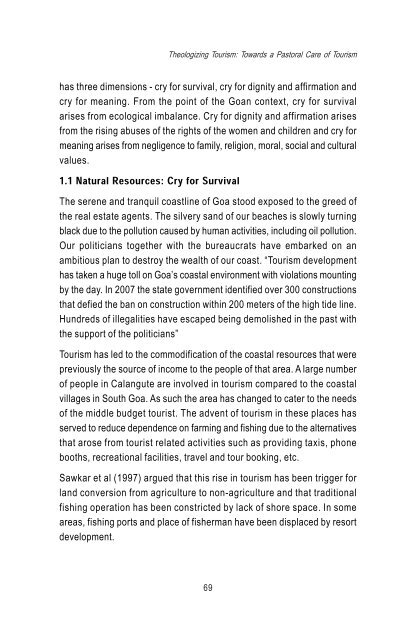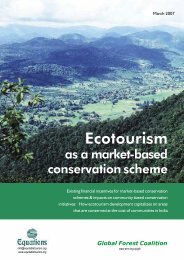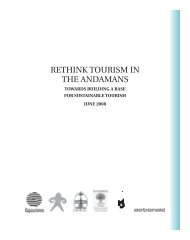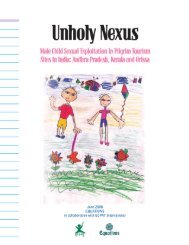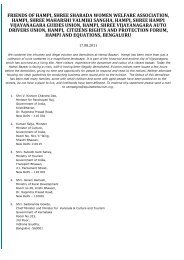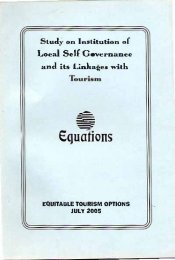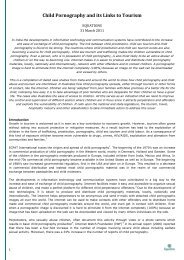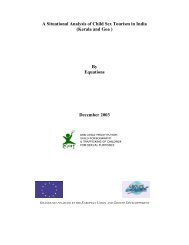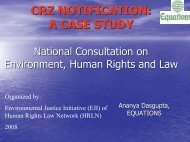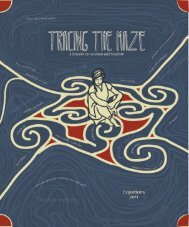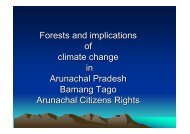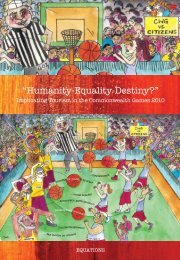Claiming the Right to Say No-30 Nov 09-EQUATIONS - Equitable ...
Claiming the Right to Say No-30 Nov 09-EQUATIONS - Equitable ...
Claiming the Right to Say No-30 Nov 09-EQUATIONS - Equitable ...
Create successful ePaper yourself
Turn your PDF publications into a flip-book with our unique Google optimized e-Paper software.
Theologizing Tourism: Towards a Pas<strong>to</strong>ral Care of Tourism<br />
has three dimensions - cry for survival, cry for dignity and affirmation and<br />
cry for meaning. From <strong>the</strong> point of <strong>the</strong> Goan context, cry for survival<br />
arises from ecological imbalance. Cry for dignity and affirmation arises<br />
from <strong>the</strong> rising abuses of <strong>the</strong> rights of <strong>the</strong> women and children and cry for<br />
meaning arises from negligence <strong>to</strong> family, religion, moral, social and cultural<br />
values.<br />
1.1 Natural Resources: Cry for Survival<br />
The serene and tranquil coastline of Goa s<strong>to</strong>od exposed <strong>to</strong> <strong>the</strong> greed of<br />
<strong>the</strong> real estate agents. The silvery sand of our beaches is slowly turning<br />
black due <strong>to</strong> <strong>the</strong> pollution caused by human activities, including oil pollution.<br />
Our politicians <strong>to</strong>ge<strong>the</strong>r with <strong>the</strong> bureaucrats have embarked on an<br />
ambitious plan <strong>to</strong> destroy <strong>the</strong> wealth of our coast. “Tourism development<br />
has taken a huge <strong>to</strong>ll on Goa’s coastal environment with violations mounting<br />
by <strong>the</strong> day. In 2007 <strong>the</strong> state government identified over <strong>30</strong>0 constructions<br />
that defied <strong>the</strong> ban on construction within 200 meters of <strong>the</strong> high tide line.<br />
Hundreds of illegalities have escaped being demolished in <strong>the</strong> past with<br />
<strong>the</strong> support of <strong>the</strong> politicians”<br />
Tourism has led <strong>to</strong> <strong>the</strong> commodification of <strong>the</strong> coastal resources that were<br />
previously <strong>the</strong> source of income <strong>to</strong> <strong>the</strong> people of that area. A large number<br />
of people in Calangute are involved in <strong>to</strong>urism compared <strong>to</strong> <strong>the</strong> coastal<br />
villages in South Goa. As such <strong>the</strong> area has changed <strong>to</strong> cater <strong>to</strong> <strong>the</strong> needs<br />
of <strong>the</strong> middle budget <strong>to</strong>urist. The advent of <strong>to</strong>urism in <strong>the</strong>se places has<br />
served <strong>to</strong> reduce dependence on farming and fishing due <strong>to</strong> <strong>the</strong> alternatives<br />
that arose from <strong>to</strong>urist related activities such as providing taxis, phone<br />
booths, recreational facilities, travel and <strong>to</strong>ur booking, etc.<br />
Sawkar et al (1997) argued that this rise in <strong>to</strong>urism has been trigger for<br />
land conversion from agriculture <strong>to</strong> non-agriculture and that traditional<br />
fishing operation has been constricted by lack of shore space. In some<br />
areas, fishing ports and place of fisherman have been displaced by resort<br />
development.<br />
69


